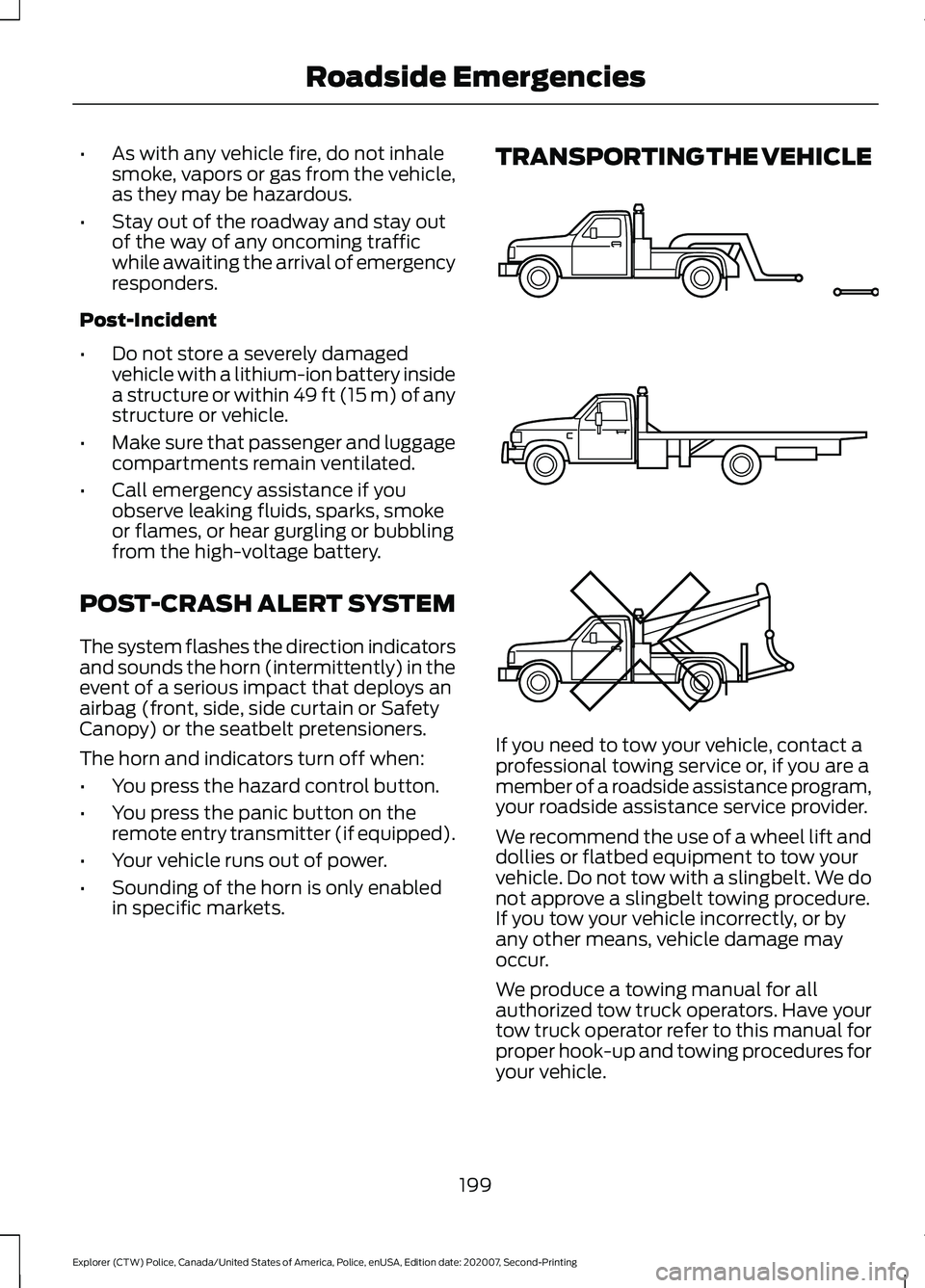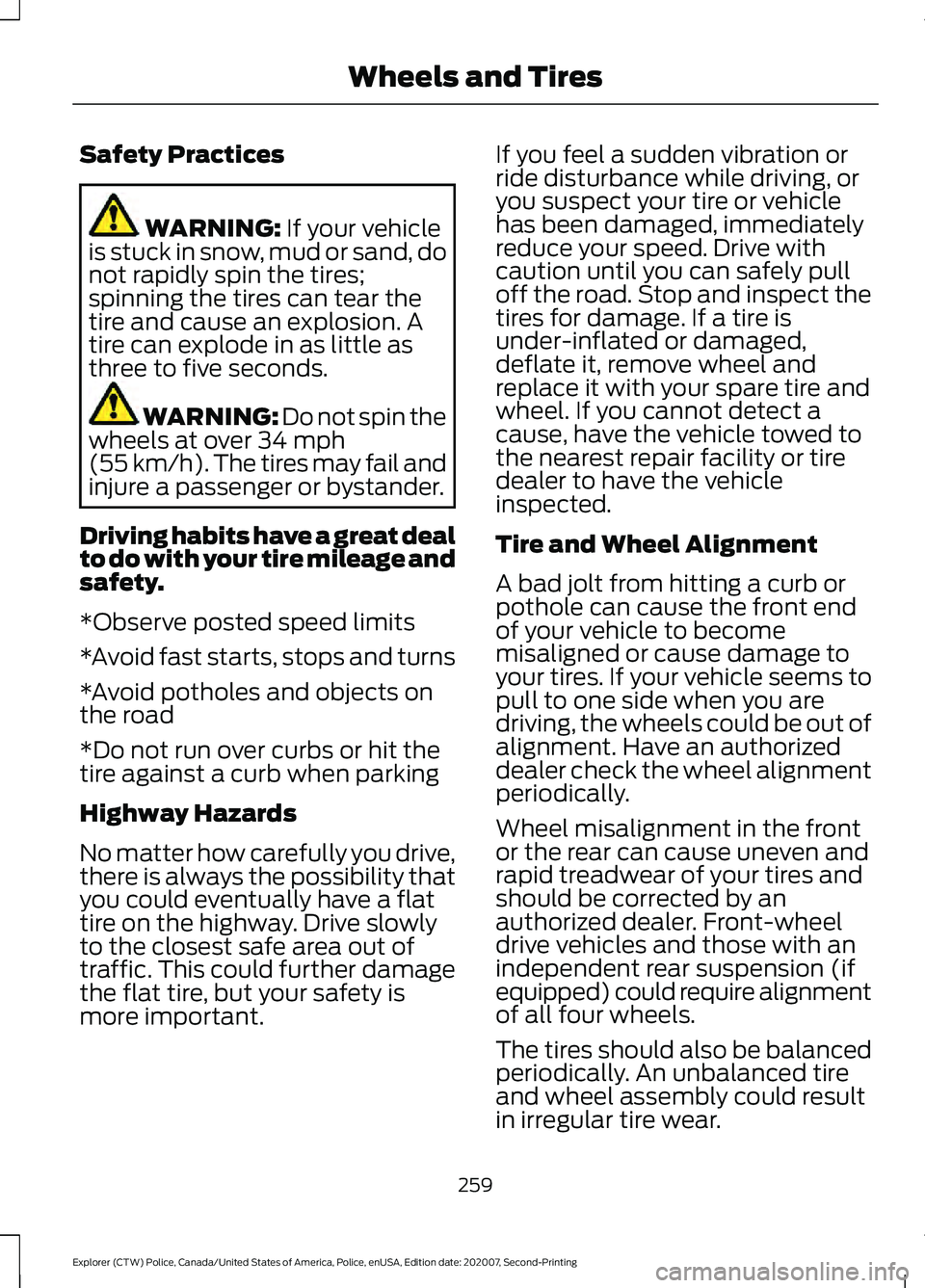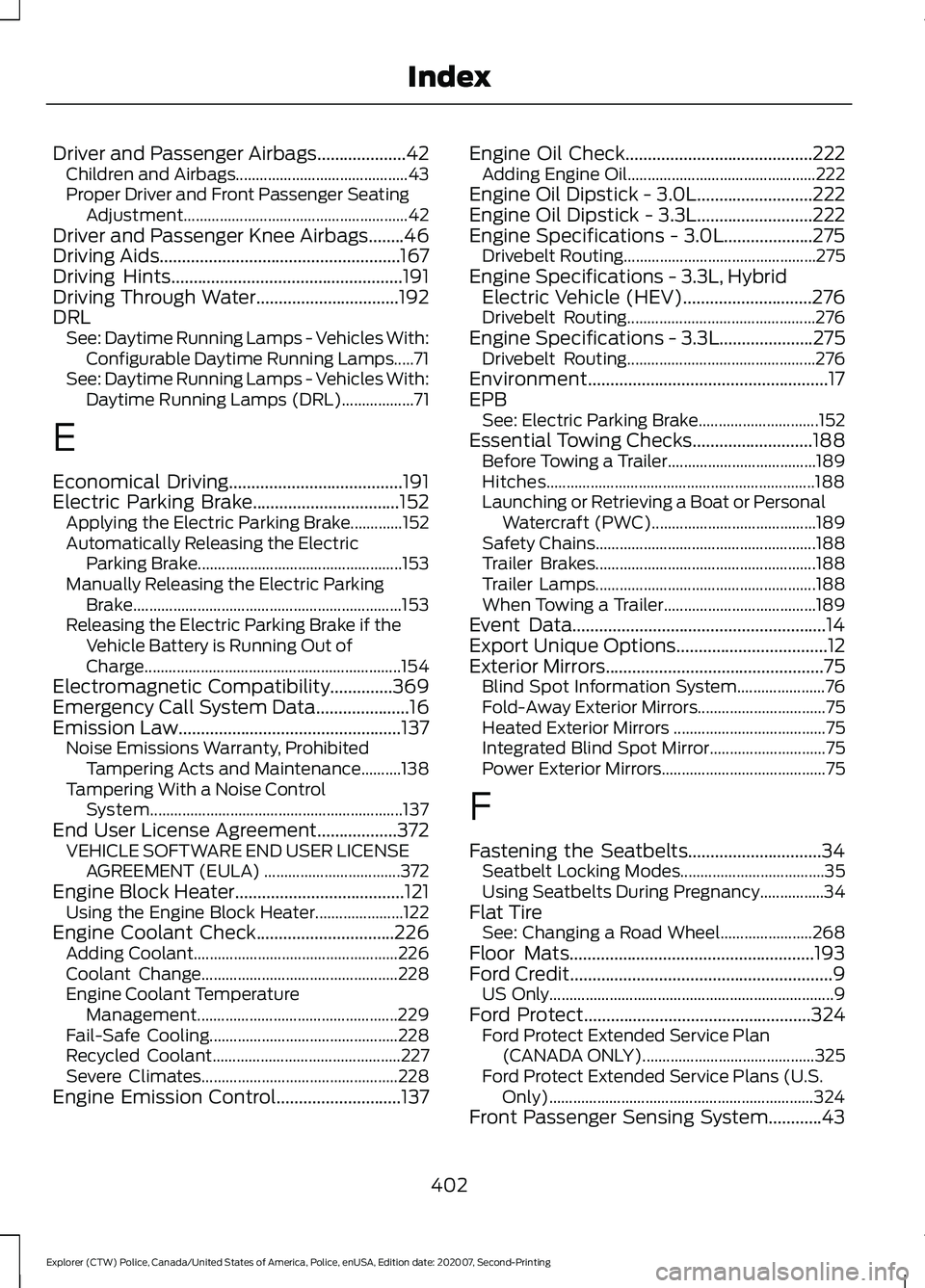2021 FORD POLICE INTERCEPTOR run flat
[x] Cancel search: run flatPage 127 of 412

Braking
Your hybrid vehicle has standard hydraulic
braking and regenerative braking. The
transmission performs regenerative
braking. It captures brake energy and
stores it in the high voltage battery. The
transmission changes gears while
decelerating and captures the maximum
energy back into the high voltage battery.
Driving to Optimize Fuel Economy
Your fuel economy should improve
throughout the hybrid vehicle break-in
period. As with any vehicle, your driving
habits and accessory usage can
significantly impact your fuel economy. For
best results, keep these tips in mind:
•
Properly inflate the recommended size
tires.
• Aggressive driving increases the
amount of energy your vehicle requires
to move. In general, you can achieve
better fuel economy with mild to
moderate acceleration and
deceleration. Moderate braking is
particularly important since it allows
you to maximize the energy the
regenerative braking system captures.
Additional tips:
• Do not carry extra loads.
• Be mindful of adding external
accessories that could increase
aerodynamic drag.
• Observe posted speed limits.
• Perform all scheduled maintenance.
• There is no need to wait for the engine
to warm up. Your vehicle is
immediately ready to drive after
starting.
Note: Having the engine running is not
always an indication of inefficiency. In some
cases, it is actually more efficient than
driving in electric mode.
124
Explorer (CTW) Police, Canada/United States of America, Police, enUSA, Edition date: 202007, Second-Printing Unique Driving Characteristics - Hybrid Electric Vehicle
(HEV)
Page 195 of 412
![FORD POLICE INTERCEPTOR 2021 Owners Manual •
Carry unnecessary weight
(approximately 1 mpg [0.4 km/L] is
lost for every 395 lb (180 kg) of weight
carried).
• Driving with the wheels out of
alignment.
Conditions
• Heavily loading a vehicl FORD POLICE INTERCEPTOR 2021 Owners Manual •
Carry unnecessary weight
(approximately 1 mpg [0.4 km/L] is
lost for every 395 lb (180 kg) of weight
carried).
• Driving with the wheels out of
alignment.
Conditions
• Heavily loading a vehicl](/manual-img/11/40632/w960_40632-194.png)
•
Carry unnecessary weight
(approximately 1 mpg [0.4 km/L] is
lost for every 395 lb (180 kg) of weight
carried).
• Driving with the wheels out of
alignment.
Conditions
• Heavily loading a vehicle or towing a
trailer may reduce fuel economy at any
speed.
• Adding certain accessories to your
vehicle (for example bug deflectors,
rollbars, light bars, running boards, ski
racks or luggage racks) may reduce
fuel economy.
• To maximize the fuel economy, drive
with the tonneau cover installed (if
equipped).
• Using fuel blended with alcohol may
lower fuel economy.
• Fuel economy may decrease with lower
temperatures during the first
5–10 mi
(12 –16 km) of driving.
• Driving on flat terrain offers improved
fuel economy as compared to driving
on hilly terrain.
• Transmissions give their best fuel
economy when operated in the top
cruise gear and with steady pressure
on the gas pedal.
• Four-wheel-drive operation (if
equipped) is less fuel efficient than
two-wheel-drive operation.
• Close the windows for high-speed
driving.
COLD WEATHER
PRECAUTIONS
The functional operation of some
components and systems can be affected
at temperatures below approximately
-13°F (-25°C)
. BREAKING-IN
Note:
Vehicles used for driver training or on
an emergency vehicle operator course must
also complete the
1,000 mi (1,600 km)
break-in process before training can begin.
You need to break in new tires for
approximately
300 mi (480 km). During
this time, your vehicle could exhibit some
unusual driving characteristics.
Do not tow during the first
1,000 mi
(1,600 km).
DRIVING THROUGH WATER WARNING:
Do not drive through
flowing or deep water as you may lose
control of your vehicle.
Note: Driving through standing water can
cause vehicle damage.
Note: Engine damage can occur if water
enters the air filter.
Before driving through standing water,
check the depth. Never drive through water
that is higher than the bottom of the front
rocker area of your vehicle. 192
Explorer (CTW) Police, Canada/United States of America, Police, enUSA, Edition date: 202007, Second-Printing Driving HintsE259345
Page 202 of 412

•
As with any vehicle fire, do not inhale
smoke, vapors or gas from the vehicle,
as they may be hazardous.
• Stay out of the roadway and stay out
of the way of any oncoming traffic
while awaiting the arrival of emergency
responders.
Post-Incident
• Do not store a severely damaged
vehicle with a lithium-ion battery inside
a structure or within 49 ft (15 m) of any
structure or vehicle.
• Make sure that passenger and luggage
compartments remain ventilated.
• Call emergency assistance if you
observe leaking fluids, sparks, smoke
or flames, or hear gurgling or bubbling
from the high-voltage battery.
POST-CRASH ALERT SYSTEM
The system flashes the direction indicators
and sounds the horn (intermittently) in the
event of a serious impact that deploys an
airbag (front, side, side curtain or Safety
Canopy) or the seatbelt pretensioners.
The horn and indicators turn off when:
• You press the hazard control button.
• You press the panic button on the
remote entry transmitter (if equipped).
• Your vehicle runs out of power.
• Sounding of the horn is only enabled
in specific markets. TRANSPORTING THE VEHICLE
If you need to tow your vehicle, contact a
professional towing service or, if you are a
member of a roadside assistance program,
your roadside assistance service provider.
We recommend the use of a wheel lift and
dollies or flatbed equipment to tow your
vehicle. Do not tow with a slingbelt. We do
not approve a slingbelt towing procedure.
If you tow your vehicle incorrectly, or by
any other means, vehicle damage may
occur.
We produce a towing manual for all
authorized tow truck operators. Have your
tow truck operator refer to this manual for
proper hook-up and towing procedures for
your vehicle.
199
Explorer (CTW) Police, Canada/United States of America, Police, enUSA, Edition date: 202007, Second-Printing Roadside EmergenciesE143886
Page 262 of 412

Safety Practices
WARNING: If your vehicle
is stuck in snow, mud or sand, do
not rapidly spin the tires;
spinning the tires can tear the
tire and cause an explosion. A
tire can explode in as little as
three to five seconds. WARNING:
Do not spin the
wheels at over 34 mph
(55 km/h). The tires may fail and
injure a passenger or bystander.
Driving habits have a great deal
to do with your tire mileage and
safety.
*Observe posted speed limits
*Avoid fast starts, stops and turns
*Avoid potholes and objects on
the road
*Do not run over curbs or hit the
tire against a curb when parking
Highway Hazards
No matter how carefully you drive,
there is always the possibility that
you could eventually have a flat
tire on the highway. Drive slowly
to the closest safe area out of
traffic. This could further damage
the flat tire, but your safety is
more important. If you feel a sudden vibration or
ride disturbance while driving, or
you suspect your tire or vehicle
has been damaged, immediately
reduce your speed. Drive with
caution until you can safely pull
off the road. Stop and inspect the
tires for damage. If a tire is
under-inflated or damaged,
deflate it, remove wheel and
replace it with your spare tire and
wheel. If you cannot detect a
cause, have the vehicle towed to
the nearest repair facility or tire
dealer to have the vehicle
inspected.
Tire and Wheel Alignment
A bad jolt from hitting a curb or
pothole can cause the front end
of your vehicle to become
misaligned or cause damage to
your tires. If your vehicle seems to
pull to one side when you are
driving, the wheels could be out of
alignment. Have an authorized
dealer check the wheel alignment
periodically.
Wheel misalignment in the front
or the rear can cause uneven and
rapid treadwear of your tires and
should be corrected by an
authorized dealer. Front-wheel
drive vehicles and those with an
independent rear suspension (if
equipped) could require alignment
of all four wheels.
The tires should also be balanced
periodically. An unbalanced tire
and wheel assembly could result
in irregular tire wear.
259
Explorer (CTW) Police, Canada/United States of America, Police, enUSA, Edition date: 202007, Second-Printing Wheels and Tires
Page 274 of 412

Note:
No maintenance or additional
lubrication of your jack is required over the
service life of your vehicle.
1. Park on a level surface, set the parking
brake and switch on the hazard
flashers.
2. Apply the parking brake, place the transmission in park (P) or reverse (R)
for manual transmission. Turn the
engine off. 3. Block the wheel diagonally opposite
the flat tire. For example, if the left
front tire is flat, block the right rear
wheel. 4. Turn the wing nut securing the spare
tire counterclockwise, remove the wing
nut.
5. Remove the spare tire, jack and wrench
from the spare tire storage
compartment under the trunk load
floor. 6. Turn the hex nut on the jack
counterclockwise to remove the lug
wrench from jack. This lowers the jack
and loosens the mechanical lock.
271
Explorer (CTW) Police, Canada/United States of America, Police, enUSA, Edition date: 202007, Second-Printing Wheels and TiresE142551 E288598 E175694
Page 276 of 412

15. Turn the wrench handle
counterclockwise to lower the vehicle
completely. 16.
Remove the jack and fully tighten the
lug nuts in the order shown. See
Technical Specifications (page
274).
17. Remove the wheel blocks. Stowing the Jack 1.
To store the folded wrench on the jack,
engage the bracket of the jack base
and the lug wrench pin, swing the
wrench upwards, adjust jack height
until the wrench hook engages the hole
on jack. Tighten the hex nut clockwise
by hand until secure.
2. Place the jack in the spare tire compartment, install the wing nut and
tighten clockwise by hand until secure.
Stowing the Flat Tire
1. Secure the flat road wheel and tire in the spare tire storage compartment
under the trunk load floor. Place the
flat road wheel and tire over the
stowed jack and secure with the wing
nut.
273
Explorer (CTW) Police, Canada/United States of America, Police, enUSA, Edition date: 202007, Second-Printing Wheels and Tires12
3
4
5E306781 E176165
Page 405 of 412

Driver and Passenger Airbags....................42
Children and Airbags........................................... 43
Proper Driver and Front Passenger Seating Adjustment........................................................ 42
Driver and Passenger Knee Airbags........46
Driving Aids......................................................167
Driving Hints....................................................191
Driving Through Water................................192
DRL See: Daytime Running Lamps - Vehicles With:
Configurable Daytime Running Lamps.....71
See: Daytime Running Lamps - Vehicles With: Daytime Running Lamps (DRL).................. 71
E
Economical Driving
.......................................191
Electric Parking Brake.................................152
Applying the Electric Parking Brake.............152
Automatically Releasing the Electric
Parking Brake................................................... 153
Manually Releasing the Electric Parking Brake................................................................... 153
Releasing the Electric Parking Brake if the Vehicle Battery is Running Out of
Charge................................................................ 154
Electromagnetic Compatibility
..............369
Emergency Call System Data.....................16
Emission Law..................................................137
Noise Emissions Warranty, Prohibited
Tampering Acts and Maintenance..........138
Tampering With a Noise Control System............................................................... 137
End User License Agreement..................372 VEHICLE SOFTWARE END USER LICENSE
AGREEMENT (EULA) .................................. 372
Engine Block Heater......................................121 Using the Engine Block Heater...................... 122
Engine Coolant Check
...............................226
Adding Coolant................................................... 226
Coolant Change................................................. 228
Engine Coolant Temperature Management.................................................. 229
Fail-Safe Cooling............................................... 228
Recycled Coolant............................................... 227
Severe Climates................................................. 228
Engine Emission Control
............................137 Engine Oil Check
..........................................222
Adding Engine Oil............................................... 222
Engine Oil Dipstick - 3.0L
..........................222
Engine Oil Dipstick - 3.3L..........................222
Engine Specifications - 3.0L....................275 Drivebelt Routing................................................ 275
Engine Specifications - 3.3L, Hybrid Electric Vehicle (HEV).............................276
Drivebelt Routing............................................... 276
Engine Specifications - 3.3L
.....................275
Drivebelt Routing............................................... 276
Environment......................................................17
EPB See: Electric Parking Brake.............................. 152
Essential Towing Checks
...........................188
Before Towing a Trailer..................................... 189
Hitches................................................................... 188
Launching or Retrieving a Boat or Personal Watercraft (PWC)......................................... 189
Safety Chains....................................................... 188
Trailer Brakes....................................................... 188
Trailer Lamps....................................................... 188
When Towing a Trailer...................................... 189
Event Data.........................................................14
Export Unique Options
..................................12
Exterior Mirrors.................................................75
Blind Spot Information System...................... 76
Fold-Away Exterior Mirrors................................ 75
Heated Exterior Mirrors ...................................... 75
Integrated Blind Spot Mirror............................. 75
Power Exterior Mirrors......................................... 75
F
Fastening the Seatbelts..............................34 Seatbelt Locking Modes.................................... 35
Using Seatbelts During Pregnancy................34
Flat Tire See: Changing a Road Wheel....................... 268
Floor Mats
.......................................................193
Ford Credit...........................................................9
US Only....................................................................... 9
Ford Protect
...................................................324
Ford Protect Extended Service Plan
(CANADA ONLY)........................................... 325
Ford Protect Extended Service Plans (U.S. Only).................................................................. 324
Front Passenger Sensing System............43
402
Explorer (CTW) Police, Canada/United States of America, Police, enUSA, Edition date: 202007, Second-Printing Index
Page 409 of 412

Rear Occupant Alert System Audible
Warnings........................................................115
Rear Occupant Alert System Indicators.......................................................115
Rear Occupant Alert System Limitations....................................................114
Rear Occupant Alert System Precautions...................................................114
Rear Occupant Alert System....................114
Rear Parking Aid............................................159
Object Distance Indicator................................. 161
Rear Passenger Climate Controls..........104 Directing Air to the Overhead Air
Vents.................................................................. 104
Directing Air to the Rear Footwell Air Vents.................................................................. 104
Rear Climate Control Lock Indicator...........104
Setting the Rear Blower Motor Speed................................................................. 105
Setting the Rear Temperature....................... 105
Switching the Rear Climate Control On and Off....................................................................... 105
Switching the Rear Heated Seats On and Off....................................................................... 105
Rear Seats
........................................................112
Adjusting the Seat Backrest............................ 112
Folding the Seat Backrest Flat........................ 112
Rear View Camera
........................................161
Camera Guide Lines.......................................... 163
Manual Zoom...................................................... 164
Obstacle Distance Indicator........................... 163
Rear Camera Delay............................................ 164
Rear Camera On Demand............................... 164
Using the Rear View Camera System.........162
Rear View Camera See: Rear View Camera..................................... 161
Rear Window Wiper and Washers...........67 Rear Camera Washer......................................... 68
Rear Window Washer......................................... 68
Rear Window Wiper Blade............................... 68
Rear Wiper Blades See: Changing the Rear Wiper Blades.......236
Recommended Towing Weights
............186
Reduced Engine Performance..................191
Refueling - Excluding: Hybrid Electric Vehicle (HEV)
.............................................130
Refueling System Overview........................... 130
Refueling System Warning.............................. 132Refueling Your Vehicle.......................................
131
Refueling - Hybrid Electric Vehicle (HEV).............................................................133
Fuel Filler Door Manual Override Lever................................................................... 135
System Warnings................................................ 134
Remote Control..............................................55 Changing the Remote Control Battery........56
Opening the Liftgate With the Liftgate
Button ................................................................. 57
Sounding the Panic Alarm................................ 57
Repairing Minor Paint Damage...............242
Replacement Parts Recommendation........................................10
Collision Repairs.................................................... 10
Scheduled Maintenance and Mechanical Repairs................................................................. 10
Warranty on Replacement Parts.................... 10
Replacing a Lost Key or Remote Control.............................................................57
Replacing the Cabin Air Filter..................106
Reporting Safety Defects (Canada Only).............................................................206
Reporting Safety Defects (U.S. Only).............................................................206
Resuming the Set Speed..........................166
Roadside Assistance
...................................194
Vehicles Sold in Canada: Getting Roadside
Assistance........................................................ 195
Vehicles Sold in the United States: Getting Roadside Assistance.................................... 194
Vehicles Sold in the United States: Using Roadside Assistance.................................... 194
Roadside Emergencies
...............................194
Running-In See: Breaking-In.................................................. 192
Running Out of Fuel.....................................128 Adding Fuel From a Portable Fuel
Container.......................................................... 129
Filling a Portable Fuel Container.................. 129
S
Safety Canopy ™
............................................46
Safety Precautions.......................................126
Scheduled Maintenance...........................326
Seatbelt Extensions......................................39
Seatbelt Height Adjustment......................36
406
Explorer (CTW) Police, Canada/United States of America, Police, enUSA, Edition date: 202007, Second-Printing Index